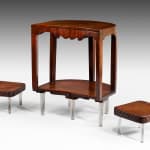George III Mahogany Insulated Table together with a pair of Mahogany Insulated Stools
26 ½ x 20 ½ x 16 in
Provenance
The table with Mallett, London, 1995.Made for conducting electrical experiments. This small insulating platform was designed to be part of a set up for experimenting with electrical equipment. If an animal, a human or a piece of equipment needed to be insulated from the ground, they could be placed on such a platform. As a result, they were made in a range of sizes. As glass does not conduct electricity, any charge applied to the object sitting on the platform would not leak away through earthing.
In the 1810 edition of the ‘Encyclopedia Britannica’, under the section headed ‘Electricity: Part II. Of Electrical Apparatus; Chap. I. Of the Construction of Electrical Machines’, it states: ‘Electrical machines should be furnished with one or more chains, by which, when insulation is not required, either of the conductors may be made to communicate with the table or with the floor. There is also attached to the electrical machine, a stool with four glass legs or feet, for the purpose of insulating various bodies in the course of experiment, hence called the insulating stool. This stool should made either of baked wood or thick glass, and be sufficiently large to support an ordinary chair at least so large that a person can easily stand on it.’ (‘Encyclopaedia Britannica; or, A Dictionary of Arts, Sciences, and Miscellaneous Literature; The Fourth Edition’, 1810, p.660).
In ‘Pike’s Illustrated Descriptive Catalogue of Optical, Mathematical and Philosophical Instruments’ (New York, 1856), Benjamin Pike, Jr. includes an ‘Insulated Stool’, along with the following description of the product: ‘This consists of well-baked wood, having stout legs, cemented in sockets for the purpose, sometimes having screws for separating them from the top, for convenient transportation.’ He follows on with instructions for use: ‘To use ; having wiped it clean and dry, let a person stand upon it, holding in his hand a chain or wire communicating with the prime conductor ; on setting the machine in action, sparks of fire may be drawn from any part of his person, he becomes indeed a part of the conductor, and is strongly electrified ; his hair will stand on end, and if he hold in his hand a silver spoon, containing some warm spirits of wine, another person may set it on fire by touching it quickly with his finger. / Price, $3.00; with legs in brass sockets / to unscrew, - $4.00 and $4.50.’ (Benjamin Pike, Jr., ‘Pike’s Illustrated Descriptive Catalogue of Optical, Mathematical and Philosophical Instruments’ (New York, 1856), p.260, fig.275).
The Wellcome Collection has an image of a demonstrator standing on an insulated stool while using an electrostatic generator.
The Science Museum Group has a similar wooden glass insulated stool (object Number: 1927-1145/1) which was once part of King George III’s personal collection and was probably used by the King himself.
Table:
Height: 26.5 inches (67.5cm)
Width: 20.5 inches (52cm)
Depth: 16 inches (40.5cm)
Stools:
Height: 7 inches (17.75cm) (2)
Width: 10.25 inches (26cm) (2)
Depth: 10.25 inches (26cm) (2)




